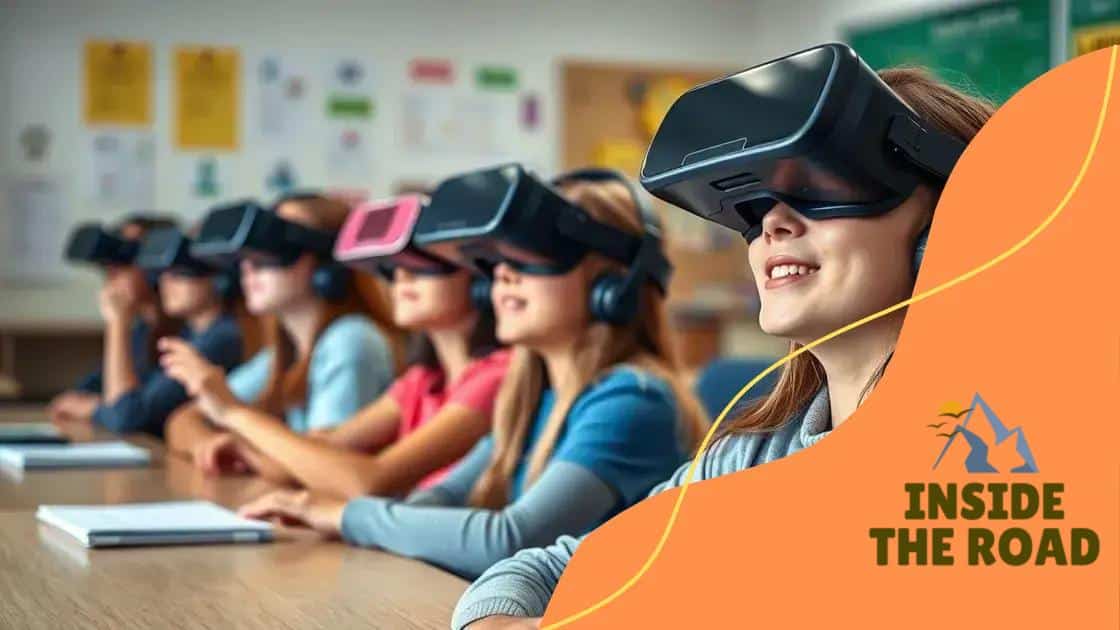Virtual reality in medical education and training

Virtual reality in medical education enhances learning through immersive simulations, allowing students to practice procedures safely while improving skills and patient care outcomes.
Virtual reality in medical education and training is changing the landscape of how future healthcare professionals learn. Imagine stepping into a fully immersive environment where you can practice procedures or explore human anatomy without any risks. This innovative approach not only enhances learning but can also lead to better patient outcomes.
Understanding virtual reality in medical training
Understanding virtual reality in medical training is essential as it revolutionizes the way students learn and practice skills. This technology provides a safe environment for realistic simulations, allowing healthcare professionals to hone their abilities without the risk of real-life consequences.
The Role of Virtual Reality
Virtual reality (VR) immerses users in a 3D environment where they can engage in simulations that closely mimic actual medical procedures. This enhanced learning experience promotes deeper understanding and retention of complex medical concepts.
Benefits of VR Training
- Safe Space: Students can practice procedures without fear of harming patients.
- Immediate Feedback: Trainees receive real-time guidance on their techniques.
- Accessible Learning: VR can be used anywhere, reducing the need for physical resources.
- Enhanced Engagement: Interactive simulations capture attention better than traditional methods.
Moreover, the hands-on experience obtained through VR training promotes critical thinking and decision-making skills. Trainees can encounter various scenarios, learning to react swiftly and correctly, which is vital in real-life medical situations.
As technology continues to advance, the applications of VR in medical training are expected to grow. This evolution not only benefits students but also ultimately enhances patient care by ensuring that healthcare providers are well-prepared.
Key benefits of VR for healthcare professionals
The key benefits of virtual reality (VR) for healthcare professionals are transforming medical training and practice. VR provides a unique opportunity for hands-on experience in an immersive and controlled environment. This technology enables professionals to refine their skills without risk, making it an invaluable tool.
Enhanced Learning Experience
With virtual reality, healthcare providers can engage in realistic simulations that mimic actual medical scenarios. This immersive learning allows them to practice complex procedures repeatedly until they feel confident. Plus, the feedback provided during these simulations helps them improve their techniques.
Improved Patient Outcomes
- Increased accuracy in procedures through meticulous practice.
- Better decision-making skills developed in pressure-filled scenarios.
- Enhanced empathy by experiencing patient perspectives.
Moreover, VR training allows healthcare professionals to encounter a variety of cases. This exposure prepares them for real-world challenges, promoting better care for patients. The opportunity to practice in a risk-free setting encourages professionals to push their limits, ultimately leading to enhanced performance.
As the field of medicine evolves, the integration of VR training is becoming essential. By utilizing this technology, healthcare professionals ensure they are well-prepared to meet the demands of their roles, significantly benefiting the healthcare system.
Real-world applications of VR in education

Real-world applications of VR in education are helping to reshape how learning occurs across various fields. This innovative technology provides immersive experiences that enhance understanding and retention of knowledge. By creating engaging simulations, students can grasp complex concepts more effectively.
Medical Training
In medical education, VR enables students to practice surgeries and procedures in a risk-free environment. This allows for repeated practice, where they can make mistakes and learn from them without endangering patients. Such simulations cultivate confidence and competence, crucial traits for future healthcare professionals.
Engineering and Design
For engineering students, VR can simulate construction sites or complex machinery, providing hands-on experiences. Students can visualize and interact with 3D models, making abstract concepts more tangible. These experiences can enhance problem-solving skills as they tackle design challenges in a virtual space.
History and Geography
- Explore ancient civilizations through virtual field trips.
- Understand geographical features with interactive maps.
- Engage in realistic reenactments of historical events.
Such educational methods foster not only engagement but also critical thinking. With virtual reality, learners interact with lessons in a way that traditional methods cannot replicate, making learning memorable and effective.
As technology continues to advance, the possibilities for VR applications in education are limitless. This advancement not only enriches the curriculum but also prepares students for real-world challenges.
Challenges in implementing VR in medical training
Implementing VR in medical training comes with several challenges that educators and institutions must navigate. While the benefits are clear, the road to effective integration of this technology can be complex.
Cost Considerations
One significant barrier is the cost of VR technology. High-quality headsets, software, and maintenance can lead to substantial expenses. Not all educational institutions have the budget to invest in this advanced equipment, which can limit access for many students.
Technical Issues
- Software glitches can disrupt training sessions.
- Hardware failures may result in costly downtime.
- Ensuring IT support is available is critical for smooth operation.
Additionally, there are challenges related to the training required for instructors. Educators must become proficient with VR technology to guide students effectively. This learning curve can create hesitance among instructors who may not be comfortable with tech-based teaching methods.
Another challenge is ensuring the content remains relevant and updated. As medical practices evolve, VR training modules must also be revised continuously to reflect the latest standards and procedures. This requires a dedicated effort from content creators and educators.
Despite these challenges, the potential rewards of implementing virtual reality in medical training make it worthwhile. Addressing these obstacles is crucial for institutions aiming to elevate their educational programs and better prepare students for future medical careers.
Future trends in virtual reality for medicine
The future trends in virtual reality for medicine hold great promise. As technology evolves, we can expect even more dynamic and effective uses of VR in healthcare settings. These advancements can greatly enhance medical training and patient care.
Integration with Artificial Intelligence
One of the most exciting trends is the integration of VR with artificial intelligence (AI). This combination can create personalized training programs for medical students. AI can analyze performance in real time and provide tailored feedback, making training more efficient and targeted.
Enhanced Simulation Capabilities
- Advanced simulations for rare procedures will become more common.
- Realistic patient interactions will improve empathy and communication skills.
- Multiplayer VR sessions may allow collaboration among students across different locations.
Furthermore, the use of VR in treatment therapy is expected to grow, providing patients with immersive experiences that can aid in their recovery processes. For example, VR can be utilized for pain management, where patients engage in calming environments, contributing positively to their healing.
Data visualization in VR is also on the rise. This will help healthcare professionals analyze complex data sets in a three-dimensional space, allowing for deeper insights into patient conditions and treatment outcomes.
As we look ahead, the possibilities are limitless. The potential for virtual reality to revolutionize the medical field continues to expand, promising improvements in training and patient care.
virtual reality in medical education offers exciting opportunities. It enhances learning experiences by providing practical, safe environments for skill development. The potential for VR to revolutionize training methods and patient care is significant. With technological advancements, we can expect even more innovative applications in the future, ultimately improving healthcare outcomes for everyone.
FAQ – Frequently Asked Questions about Virtual Reality in Medical Education
What are the main benefits of using VR in medical training?
The main benefits include enhanced learning experiences, safe practice environments, and improved patient care by better preparing healthcare professionals.
How does VR improve empathy in medical training?
VR allows students to experience situations from a patient’s perspective, fostering understanding and empathy by immersing them in realistic scenarios.
What challenges do institutions face when implementing VR?
Challenges include high costs, technical issues, the need for instructor training, and ensuring that content stays updated with current medical practices.
What future trends can we expect in VR for medicine?
Future trends include the integration of AI for personalized training, enhanced simulation capabilities, and the use of VR in treatment therapies for patients.






